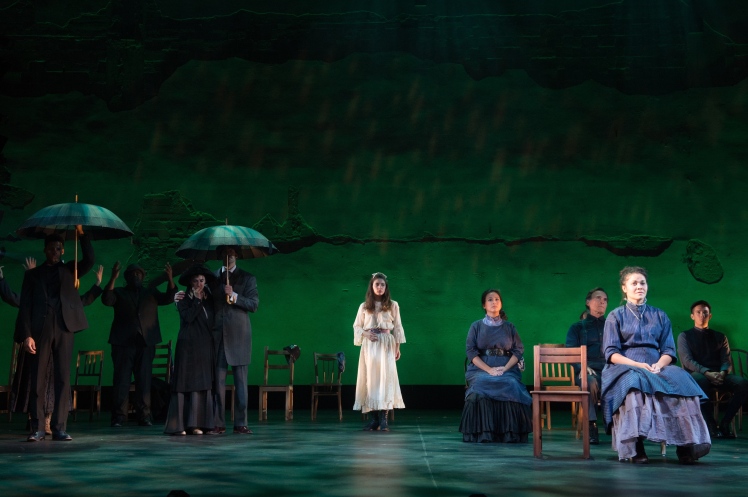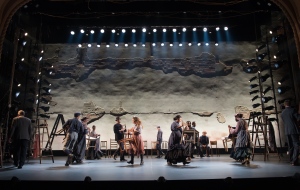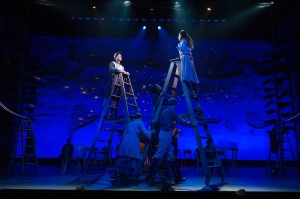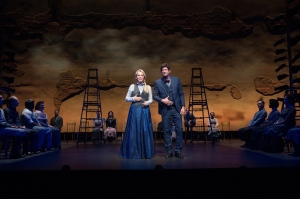
“Does anyone ever realize life while they live it?” When Our Town, Thornton Wilder’s Pulitzer-winning classic play that examines small town American life through a meta play-within-a-play format, first premiered, the Pasadena Playhouse became of the first theaters to produce it in 1939. Now, for their 100th season, they are presenting the play once more in a co-production with Deaf West Theatre. Performed simultaneously in English and American Sign Language, creating theater fully accessible to both the deaf and hearing communities as per Deaf West’s mission statement, many of the core themes of Our Town have stood the test of time, offering smart commentary on the fleeting nature of life.

Our Town consists of three acts, each of which is more interesting and poignant than the last. The action is overseen by a stage manager (Jane Kaczmarek, with ASL by Alexandria Wailes, Troy Kotsur, and Russell Harvard), who directly addresses the audience and introduces the cast and the play, which is set in whichever theater the performance is taking place in at the time. The set is intentionally bare bones—there are just chairs and minimal props, leaving the actors to mime most actions. In Act I: Daily Life, we meet the people of Grover’s Corners, New Hampshire on a typical day in 1901. Act II: Love and Marriage takes place three years later. It is the day of Emily Webb (Sandra Mae Frank, with Sharon Pierre-Louis as her voice) and George Gibbs’ (Deric Augustine) wedding, and includes a flashback to the day a year earlier when their love story truly began in earnest. Act III: Death and Dying picks up nine years later, with Emily’s death due to complications from childbirth.

In a program note, Deaf West Artistic Director DJ Kurs states that this version of Grover’s Corners is meant to evoke communities in 17th and 18th century New England where signing was predominant due to a geographical, genetic preeminence of deafness. Accounts that exist of life in these communities, notably Chilmark in Martha’s Vineyard and Henniker, New Hampshire, suggest that everyone in these towns knew sign language and communication was relatively uninterrupted, resulting in a lack of a class divide between the deaf and the hearing. When the American School for the Deaf was founded these communities became a thing of the past, and many look back at their existence as significant because they represent a rare moment in time when the deaf had full access to communication. It would be nearly impossible for this backstory to come across in an existing text, but the integration of ASL is seamless nonetheless. Deaf West productions can run the gamut from full incorporation of ASL into the text and story (Spring Awakening) to a more traditional performance that is interpreted by another set of actors on the sidelines (At Home at the Zoo). Our Town lives somewhere in the middle of this spectrum—every member of the ensemble signs, and specific characters are portrayed as deaf while others are not. Much like it was in those deaf communities of the 1600s and 1700s, the inclusion of ASL is seamless and organic, simply a part of daily life in Grover’s Corners. Lines such as “once in your life before you die you ought to see a country where they don’t talk in English and don’t even want to” take on a new meaning in this context.

One of the most interesting things about Our Town is that from a production standpoint it is largely a blank slate with a great deal of creative opportunity. Directed here by Sheryl Kaller, this take has some lovely moments, as well as some that feel like missed opportunities. The role of the stage manager has more often than not been played by male actors, so Kaczmarek’s casting feels refreshing, although her performance on opening night was a bit disappointing. There were multiple significant line flubs, which was all the more perplexing given that she carried around the script as a prop. While this is easy to justify given the character and the meta nature of the play, combined with the rather severe mistakes it felt suspiciously like a result of under-preparedness. Aside from the fact that it is performed simultaneously in two languages, nothing else in the staging felt particularly innovative or different. Over the years, many theater companies have put their own spin on this show. In Transport Group’s Off-Broadway production in 2002, the stage manager was played by a 12-year-old girl and Emily by a 63-year-old woman; in 2009 at the Barrow Street Theater, the characters wore contemporary clothing, carried cell phones, and cooked real bacon onstage. I mention these merely as examples of the type of creative freedom this ultimately simple play offers rather than as a point of comparison, but I could not help but feel a little bored by just how traditional and expected this staging was.

Act III is by far the best in a very strong play full of memorable quotes and wise musings. Emily dies and is desperate to return to Earth after hearing she has the option to revisit one day in her life as an observer. While her fellow deceased citizens of Grover’s Corners strongly caution her against it, she chooses the day of her 12th birthday. Emily becomes immediately frustrated by how this memory she had treasured does not hold up to scrutiny because no one experiencing the moment at the time seems, from an outsider’s perspective, to actually be experiencing it at all. Everyone is distracted, taking what she looks back on as a lovely if unremarkable day for granted. This is a beautiful sentiment that applies to both today’s culture, when so many people spend precious time glued to technology rather than immersed in the world, and also to what I love so dearly about theater, which demands an audience’s presence more than any other art form. Frank’s performance as Emily is lovely and heartbreaking, but perhaps even more impressive is that of Pierre-Louis, who finds intense depth of emotion despite only speaking the role. The lighting (Jared A. Sayeg) is beautiful throughout but never more so than during this final sequence, when the color scheme shifts to signify Emily’s movement between the world of the living and the world of the dead.
Sure, there are parts of Our Town that cannot help but feel dated—the gender politics in particular are old-fashioned, with many lines of dialogue about how great the women are at cooking and homemaking. But in a world that feels more fractured and more damaged by the day, the reminder about the importance of appreciating every minute and living life to the fullest is perhaps more crucial than ever.
Our Town runs at the Pasadena Playhouse through October 22nd. The running time is 2 hours and 50 minutes, including two intermissions. Tickets start at $25 and can be purchased here.
I have been following Deaf West for a while and was lucky enough to see their production of The Zoo Story at the Wallis Annenberg last spring. I think it’s interesting that they are doing more plays, but ASL plays so well into dance, that I almost feel like their musicals were more effective! I still love what they’re doing, though! I really enjoyed your article!
LikeLike